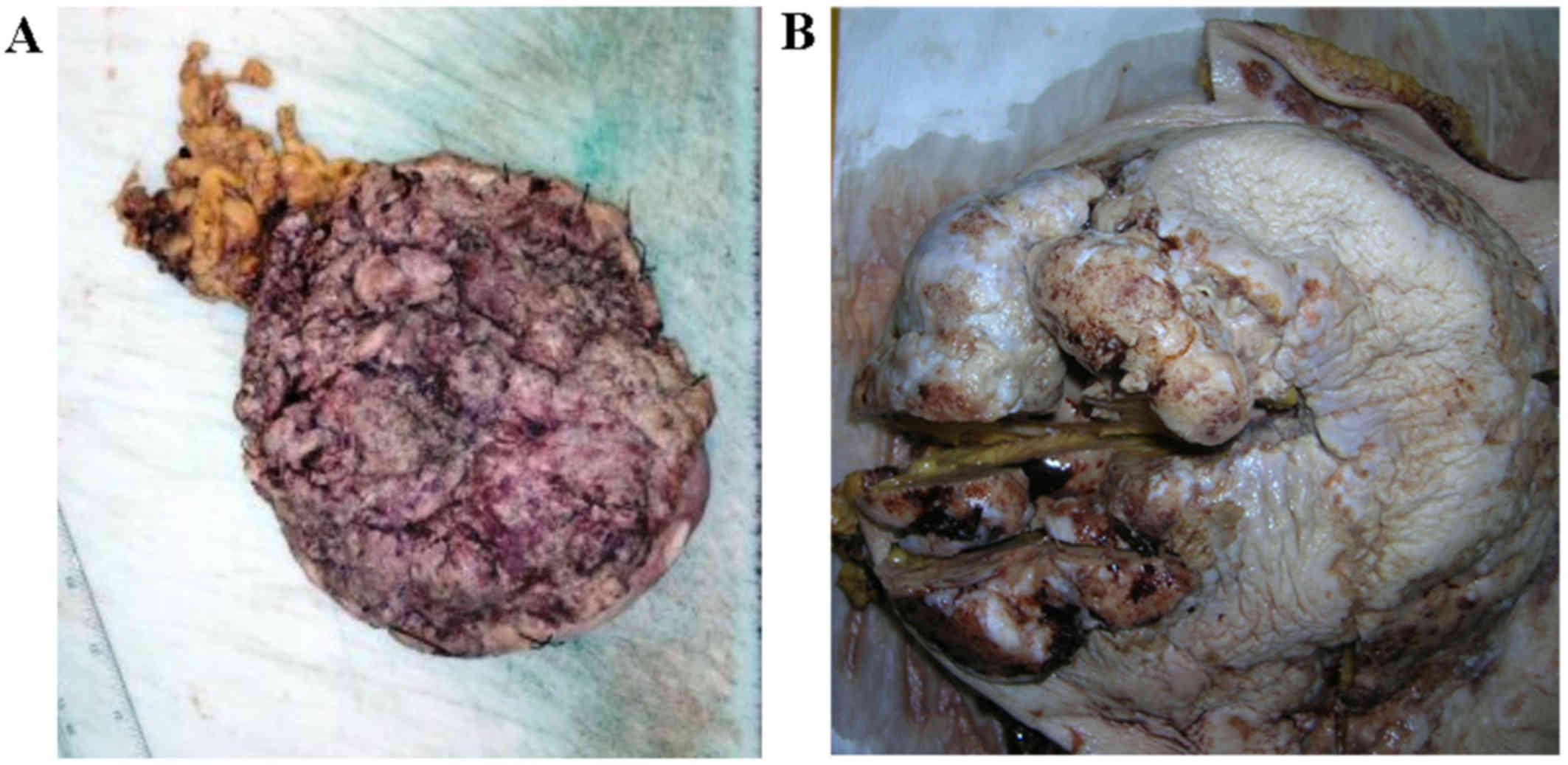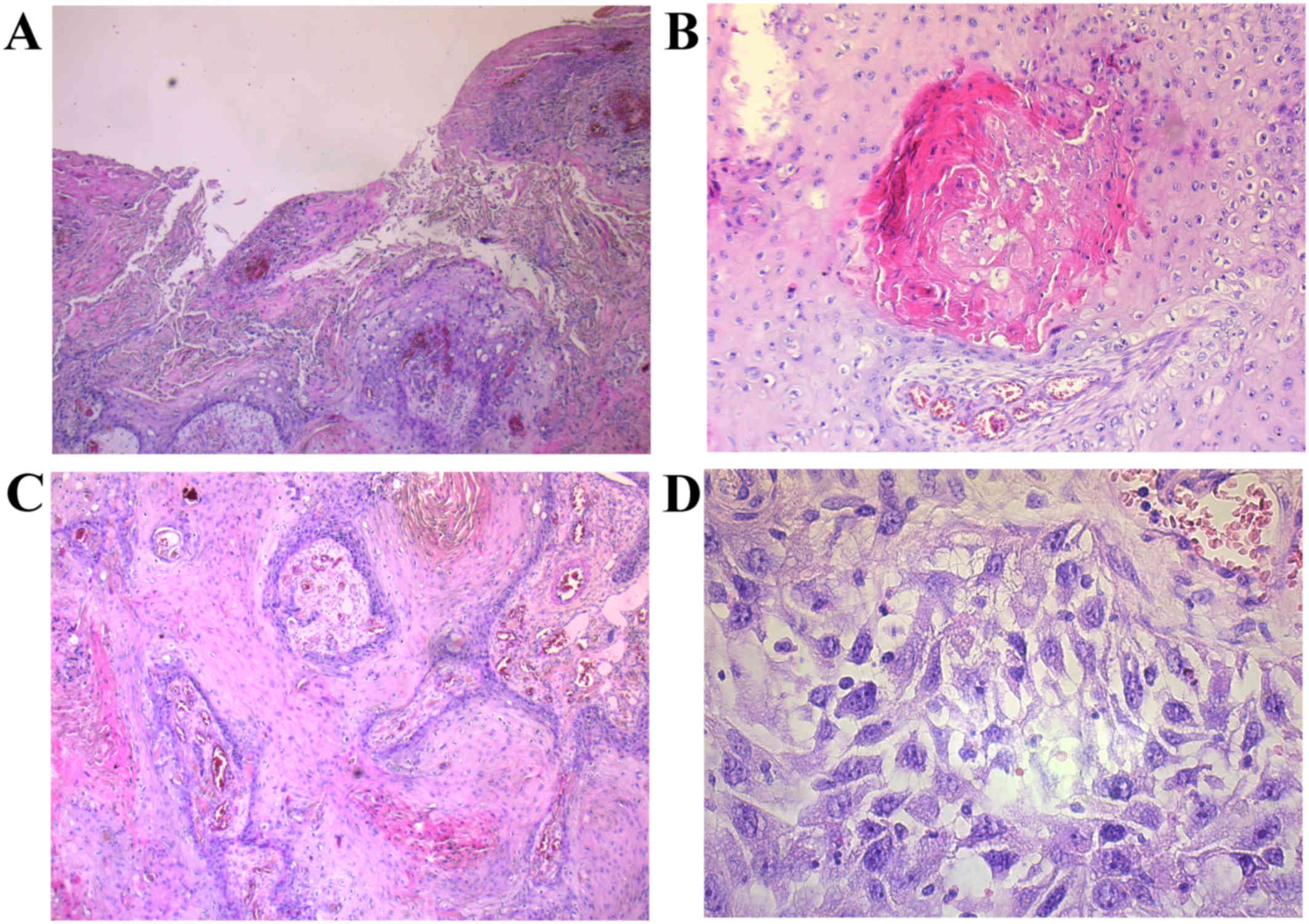|
1
|
Hennessy BT, Krishnamurthy S, Giordano S,
Buchholz TA, Kau SW, Duan Z, Valero V and Hortobagyi GN: Squamous
cell carcinoma of the breast. J Clin Oncol. 23:7827–7835. 2005.
View Article : Google Scholar : PubMed/NCBI
|
|
2
|
Tavassoli FA and Devilee P: Metaplastic
carcinomasPathology and Genetics. Tumours of the Breast and Female
Genital Organs. World Organization Classification of Tumors. IARC
Press; Lyon: pp. 37–38. 2003
|
|
3
|
Rosen PR: Chapter 21. Rosen's Breast
Pathology. Lippincott-Raven; Philadelphia, New York: pp. 397–404.
1997
|
|
4
|
Leboit PE, Burg G, Weedon D and Sarasin A:
Squamous Cell CarcinomaPathology and Genetics. Skin Tumors. World
Organization Classification of Tumors. IARC Press; Lyon: pp. 20–21.
2007
|
|
5
|
Miranda BH, Malahias M, El-Said TF and
Fahmy FS: Axillary skin malignancy: A rare breast cancer
presentation. Ann Plast Surg. 72:513–514. 2014. View Article : Google Scholar : PubMed/NCBI
|
|
6
|
Badge SA, Gangane NM, Shivkumar VB and
Sharma SM: Primary squamous cell carcinoma of the breast. Int J
Appl Basic Med Res. 4:53–55. 2014. View Article : Google Scholar : PubMed/NCBI
|
|
7
|
Mitra B, Pal M, Debnath S, Paul B, Saha TN
and Maiti A: Primary squamous cell carcinoma of breast with
ipsilateral axillary lymph node metastasis: An unusual case. Int J
Surg Case Rep. 2:194–197. 2011. View Article : Google Scholar : PubMed/NCBI
|
|
8
|
Flikweert ER, Hofstee M and Liem MS:
Squamous cell carcinoma of the breast: A case report. World J Surg
Oncol. 6:1352008. View Article : Google Scholar : PubMed/NCBI
|
|
9
|
Tsung SH: Primary pure squamous cell
carcinoma of the breast might be sensitive to Cisplatin-based
chemotherapy. Case Rep Oncol. 5:561–565. 2012. View Article : Google Scholar : PubMed/NCBI
|
|
10
|
Bhosale SJ, Kshirsagar AY, Deshmukh SJ,
Jagtap SV and Langade YB: Squamous cell carcinoma of the breast. Am
J Case Rep. 14:188–190. 2013. View Article : Google Scholar : PubMed/NCBI
|
|
11
|
Wang J, Zhang X, He J, Yang M, Tang J, Li
X, Tang H and Xie X: Co-expression of EGFR and CK5/6 in primary
squamous cell carcinoma of the breast. Med Oncol. 31:1722014.
View Article : Google Scholar : PubMed/NCBI
|
|
12
|
Porzio R, Cordini C, Orsi N, Brigati F,
Paties CT and Cavanna L: Primary squamous cell carcinoma of the
breast after cured bilateral breast cancer. In Vivo. 28:1155–1158.
2014.PubMed/NCBI
|
|
13
|
Mokhtar GA: Squamous cell carcinoma of the
breast. Saudi Med J. 30:1346–1349. 2009.PubMed/NCBI
|
|
14
|
Sharma R, Usmani S and Siegel R: Primary
squamous cell carcinoma of breast in background of phyllodes
tumor-a case report. Conn Med. 73:341–343. 2009.PubMed/NCBI
|
|
15
|
Cichon P, Drucis K and Piotrkowski J:
Primary squamous cell carcinoma of the breast-a case report. Pol
Merkur Lekarski. 38:140–143. 2015.(In Polish). PubMed/NCBI
|
|
16
|
Samuels TH, Miller NA, Manchul LA,
DeFreitas G and Panzarella T: Squamous cell carcinoma of the
breast. Can Assoc Radiol J. 47:177–182. 1996.PubMed/NCBI
|
|
17
|
Salemis NS: Breast abscess as the initial
manifestation of primary pure squamous cell carcinoma: A rare
presentation and literature review. Breast Dis. 33:125–131. 2011.
View Article : Google Scholar : PubMed/NCBI
|
|
18
|
Nair VJ, Kaushal V and Atri R: Pure
squamous cell carcinoma of the breast presenting as a pyogenic
abscess: A case report. Clin Breast Cancer. 7:713–715. 2007.
View Article : Google Scholar : PubMed/NCBI
|
|
19
|
Liu J, Yu Y, Sun JY, He SS, Wang X, Yin J
and Cao XC: Clinicopathologic characteristics and prognosis of
primary squamous cell carcinoma of the breast. Breast Cancer Res
Treat. 149:133–140. 2015. View Article : Google Scholar : PubMed/NCBI
|
|
20
|
Behranwala KA, Nasiri N, Abdullah N, Trott
PA and Gui GP: Squamous cell carcinoma of the breast:
Clinico-pathologic implications and outcome. Eur J Surg Oncol.
29:386–389. 2003. View Article : Google Scholar : PubMed/NCBI
|
|
21
|
Shui R, Li A, Yang F, Zhou X, Yu B, Xu X
and Yang W: Primary squamous cell carcinoma of the breast with
unusual basal-HER2 phenotype. Int J Clin Exp Pathol. 7:5203–5209.
2014.PubMed/NCBI
|
|
22
|
Lebbe C, Becker JC, Grob JJ, Malvehy J,
Del Marmol V, Pehamberger H, Peris K, Saiag P, Middleton MR,
Bastholt L, et al: Diagnosis and treatment of merkel cell
carcinoma. European consensus-based interdisciplinary guideline.
Eur J Cancer. 51:2396–2403. 2015. View Article : Google Scholar : PubMed/NCBI
|
|
23
|
Kurpad V, Prabhu KC, Ramesh MK and
Harindranath HR: Primary denovo squamous cell carcinoma breast
masquerading as breast abscess. Indian J Surg Oncol. 4:48–51. 2013.
View Article : Google Scholar : PubMed/NCBI
|
|
24
|
Murialdo R, Boy D, Musizzano Y, Tixi L,
Murelli F and Ballestrero A: Squamous cell carcinoma of the breast:
A case report. Cases J. 2:73362009.PubMed/NCBI
|
|
25
|
Rowe DE, Carroll RJ and Day CL Jr:
Prognostic factors for local recurrence, metastasis, and survival
rates in squamous cell carcinoma of the skin, ear, and lip.
Implications for treatment modality selection. J Am Acad Dermatol.
26:976–990. 1992. View Article : Google Scholar : PubMed/NCBI
|
|
26
|
Schmults CD, Karia PS, Carter JB, Han J
and Qureshi AA: Factors predictive of recurrence and death from
cutaneous squamous cell carcinoma: A 10-year, single-institution
cohort study. JAMA Dermatol. 149:541–547. 2013. View Article : Google Scholar : PubMed/NCBI
|
|
27
|
Nayak A, Wu Y and Gilcrease MZ: Primary
squamous cell carcinoma of the breast: Predictors of locoregional
recurrence and overall survival. Am J Surg Pathol. 37:867–873.
2013. View Article : Google Scholar : PubMed/NCBI
|












